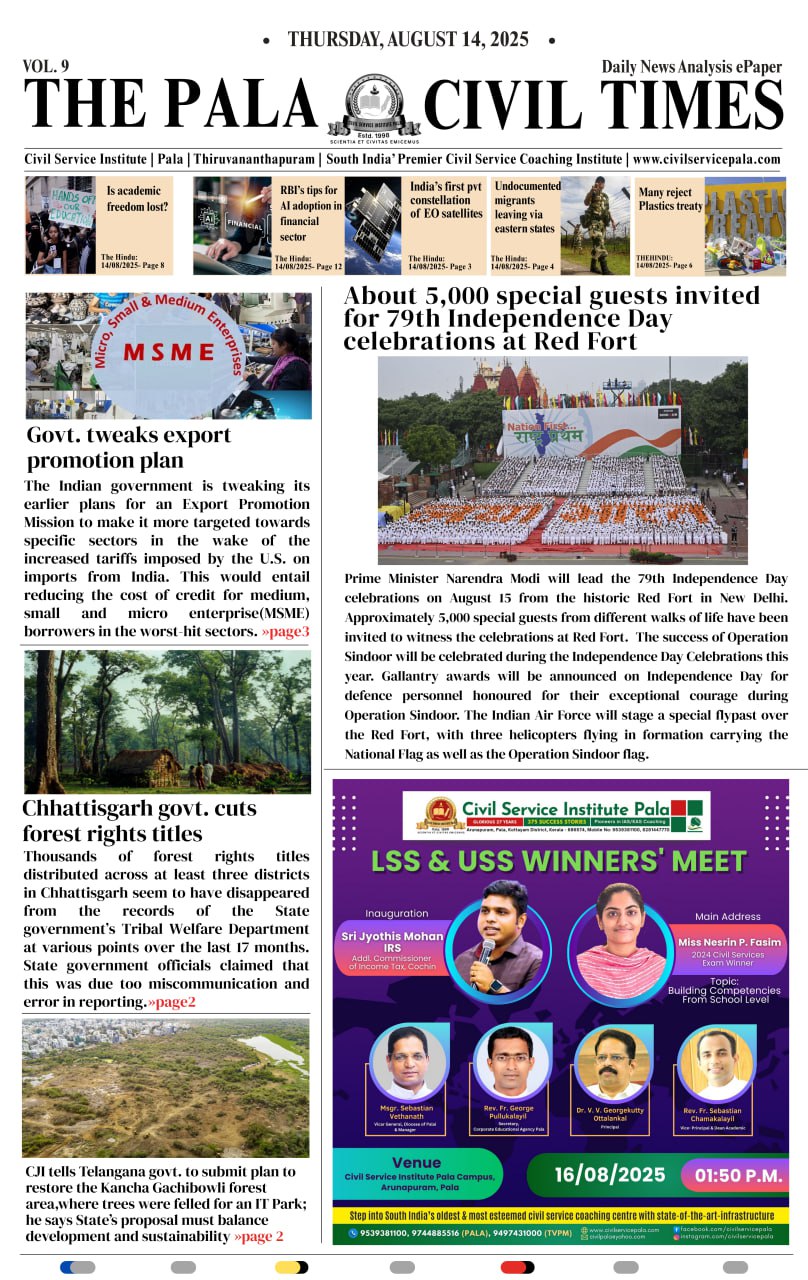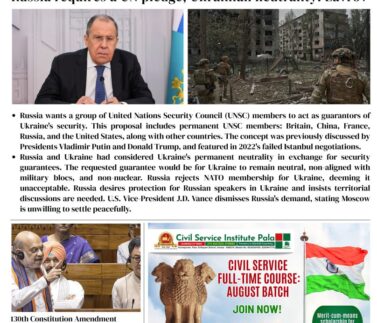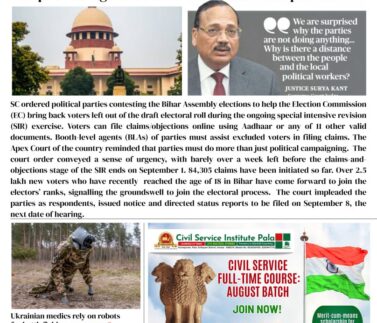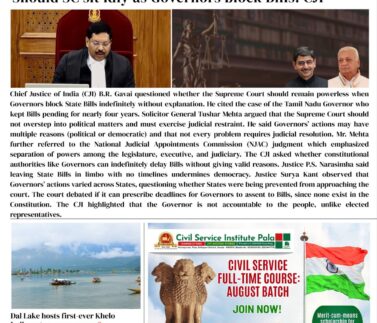
Daily News – 14-08-2025
About 5,000 special guests invited for 79th Independence Day celebrations at Red Fort
Prime Minister Narendra Modi will lead the 79th Independence Day celebrations on August 15 from the historic Red Fort in New Delhi. Approximately 5,000 special guests from different walks of life have been invited to witness the celebrations at Red Fort. The success of Operation Sindoor will be celebrated during the Independence Day Celebrations this year. Gallantry awards will be announced on Independence Day for defence personnel honoured for their exceptional courage during Operation Sindoor. The Indian Air Force will stage a special flypast over the Red Fort, with three helicopters flying in formation carrying the National Flag as well as the Operation Sindoor flag.
Chhattisgarh govt. cuts thousands of forest rights titles
Disappearance of Titles
- Thousands of forest rights titles in at least three districts of Chhattisgarh have gone missing from official records over the last 17 months.
- Data accessed through RTI shows large decreases in both Individual Forest Rights (IFR) and Community Forest Rights (CFR) titles.
Specific Figures
- Bastar district:
- IFR titles dropped from 42,632 to 39,854 between Jan 2024 and May 2025 (loss of 2,778 titles).
- CFR titles fell from 1,032 to 509 in the same period. Bijapur district:
- CFR titles dropped sharply from 1,002 to 299 within a month in 2024.
- Dantewada district:
- Similar reductions recorded, though exact figures not detailed.
Government’s Explanation
- State officials attribute the decrease to “miscommunication” and “errors in reporting”, not policy decisions.
- Claimed as part of “correction” of records rather than withdrawal of rights.
Legal Context
- Forest Rights Act (FRA) 2006 recognises rights of Scheduled Tribes and other forest-dwelling communities.
- Grants individuals/community titles for forest land use, cultivation, or collection of produce.
Impact & Concerns
- Experts warn the drop could signal an “anomaly”, as there is no FRA process for cancelling issued titles.
- Loss of titles threatens livelihoods and access to forest resources for affected communities.
- Extent of Impact
- These three districts together hold over 43% of all forest rights titles issued under FRA in Chhattisgarh.
Will remove adverse remark if all trees are replanted: SC
Supreme Court Condition
- Chief Justice of India B.R. Gavai stated that the Telangana government must first submit a concrete plan to restore the Kancha Gachibowli forest before adverse remarks against the State can be removed.
- Restoration must involve replanting all trees that were cut in the devastated forest area.
Background
- Over 100 acres of forest near the University of Hyderabad were cleared for an IT infrastructure project, sparking protests.
- In May, the SC gave Telangana two options:
- Restore the Kancha Gachibowli forest.
- Face the prospect of the Chief Secretary and several officials being sent to a “temporary prison”.
CJI’s Remarks
- Environment protection must be prioritized.
- If all trees are replanted, SC will replace adverse remarks with “real compliments.”
- The State must balance development and sustainability.
Next Steps
- Telangana to submit its restoration plan to the court.
- The case will be reviewed in six weeks.
State’s Assurance
- Senior advocate A.M. Singhvi assured the court that the State’s plan would meet environmental and developmental expectations.
Earlier Order
- On March 4, the SC barred any activity that would reduce forest cover across the country.
Govt. tweaks export promotion plan to soften blow of U.S. tariffs
Reason for Change
- The U.S. has increased tariffs on Indian imports, affecting sectors such as textiles, shrimp exporters, organic chemicals, and machinery.
- Government is modifying the Export Promotion Mission announced in the Budget to target these worst-hit sectors.
- Main Measures
- Reduce cost of credit for MSME (medium, small, and micro enterprise) exporters.
- Expedite clearances.
- Provide export incentives.
- Offer credit guarantees and cross-border factoring support.
- Assist MSMEs in tackling non-tariff measures in overseas markets.
- Budget Allocation
- ₹2,250 crore allocated for the current financial year for the tweaked Export Promotion Mission.
Sector-Specific Approach
- Focus on apparel, textiles, shrimp, organic chemicals, machinery, and mechanical appliances.
- Coordination with Ministry of Textiles and Department of Fisheries for targeted measures.
Credit Guarantee Scheme
- Announced earlier in January: loans up to ₹100 crore for MSME exporters.
- Scheme refocused on boosting export activities of MSMEs.
Government’s Broader Goal
- Facilitate immediate relief measures and develop a long-term, resilient trade strategy to withstand global shocks.
Industry Involvement
- Authorities are consulting extensively with exporters, sector representatives, and trade analysts to refine measures.
PRELIMS CORNER :
- Zmiinyi island was in the news due to the ongoing war between Ukraine and On which of the below sea is this island located?
- Caspian Sea
- Dead Sea
- Black Sea
- Azov Sea
- He was the commander of the Ahom forces and an icon of Assamese nationalism. In 1669, Aurangzeb dispatched the Rajput Raja Ram Singh I to recapture territories won back by the Ahoms in previous battles. He fought against the Mughals and won the Battle of Saraighat (Naval battle) on the River Brahmaputra. Today, His victory is honored with a gold medal given yearly to the best cadet graduating from the National Defence Academy (NDA). Which of the below Personalities suits the above statements?
- Kanaklata Barua
- Paona BrajaBashi
- Lachit Borphukan
- Haipou Jadonang
- The Global Environment Outlook report is released by
- United NationsFood and Agriculture Organisation
- World Economic Forum
- Oxfam International
- United Nations Environment Programme
India’s first private constellation of EO satellites under PPP model to be set up
- The Indian National Space Promotion and Authorisation Centre (IN-SPACe) selected the PixxelSpace India-led consortium to design, build, and operate India’s first fully indigenous commercial Earth Observation (EO) satellite constellation.
- This will be implemented under the Public-Private Partnership (PPP) model.
Consortium Members
- PixxelSpace India (lead)
- Piersight Space
- Satsure Analytics India
- Dhruva Space
Significance
- First time in Indian space sector history that a private consortium will invest over ₹1,200 crore over five years to launch a constellation of state-of-the-art EO satellites.
- Will reduce India’s reliance on foreign sources and ensure data sovereignty.
Applications of EO Constellation
- Analysis Ready Data (ARD) and Value-Added Services (VAS) for:
- Climate change monitoring Disaster management
- Agriculture
- Marine surveillance National security
- Urban planning
- Cater to global demand for high-quality geospatial intelligence.
Expected Outcomes
- Generation of high-resolution, indigenous satellite data.
- Strengthening India’s private space industry capabilities for large-scale, technologically advanced, and commercially viable missions.
Official Statement
- Pawan Goenka, Chairman of IN-SPACe, called it a milestone for India’s private space sector, showcasing capability in leading commercial space missions.
‘Undocumented migrants leaving via eastern border tripled in 2025’
Sharp Increase in Voluntary Exits
- Till July 15, 2025, 3,536 undocumented migrants (suspected to be from Bangladesh) were caught by the BSF while voluntarily leaving India via the eastern border — more than 3 times the 2024 figure of 1,049.
- Voluntary exits differ from “pushback” (forcible return), as they involve migrants leaving on their own.
Related Figures
- Migrants stopped while entering India from Bangladesh in 2025 (till July 15): 1,372 (down from 2,425 in 2024).
- In 2023, 3,342 such individuals were caught; since 2018, 37,637 Bangladeshi nationals have been intercepted.
Reasons for the Surge
- Political changes in Bangladesh on August 5, 2024 triggered increased undocumented exits.
- Ministry of Home Affairs (MHA) ordered police to detect and deport Bangladeshis living illegally on forged documents.
Security Measures
- BSF has been on heightened vigil along the 4,096 km India-Bangladesh border since August 2024, following MHA orders to prevent undocumented entry.
Pushback Controversy
- MHA estimated around 2,500 people have been “pushed back” across the eastern border.
- BSF denies pushback, calling it a “long legal procedure” when people are not involved in serious crimes.
- Trinamool Congress MP claimed at least seven people from West Bengal were illegally pushed into Bangladesh but later brought back by court order.
Context
- Increase linked to security tightening after the Pahalgam terror attack on April 22, 2025.
- Drive to detect undocumented migrants intensified thereafter.
1950 quake that broke mountains is a portend of things to come
Historical Event
- On August 15, 1950, a massive earthquake of magnitude 8.6 struck Assam and parts of Northeast India, Myanmar, and Tibet.
- Known as the “Assam-Tibet earthquake”, it remains one of the strongest recorded on land.
- Triggered massive landslides, floods, and destruction across over 4,000 sq. miles; killed at least 1,526 people (likely higher due to missing persons).
Geological Cause
- Occurred due to the collision of the Indian and Eurasian continental plates, which formed the Himalayas.
- The earthquake was shallow-focus (depth ~15 km) and caused uplift of mountains and large-scale crustal movement.
Seismic Activity in the Region
- The Indian plate moves north at about 20 mm/year, pushing into the Eurasian plate.
- In the Eastern Himalayas, movement is faster (10–38 mm/year), increasing earthquake risk.
- Region is highly seismically active due to complex fault lines, plate convergence, and strain accumulation.
Past & Potential Future Quakes
- Northeast India has experienced major quakes in 1548, 1596, 1697, and 1762 (all >8 magnitude).
- Studies suggest another 1950-type earthquake is possible due to ongoing tectonic movement.
- The Eastern Himalayas are considered one of the most earthquake-prone zones in the world.
Scientific Monitoring
- GPS and seismic data help track strain build-up and plate movement.
- Understanding past quakes aids in predicting future seismic threats, though exact prediction remains impossible.
Preparedness Concerns
- Current urban planning and construction in the Northeast do not fully account for the possibility of a megaquake.
- Experts call for stricter building codes, public awareness, and early-warning systems.
The ceding of academic freedom in universities
Core Idea
- Academic freedom is vital for questioning, exploring new ideas, and developing knowledge in higher education.
- Universities must allow both faculty and students to raise questions, critique authorities, and express opinions without fear.
Why Academic Freedom Matters
- Encourages critical thinking, creativity, and the advancement of knowledge.
- Research priorities should be decided by universities and faculty, not external authorities.
- Funding for research must be free from prejudice and based on merit.
- Dissenting opinions and unorthodox ideas should be welcomed.
Current Reality in India
- Universities face increasing restrictions; curricula are regulated and research choices are influenced by government agencies.
- Government funding and control over research make independent inquiry difficult.
- Faculty face administrative or legal action for participating in certain events or making anti-government statements.
- Social media posts can lead to disciplinary measures.
Impact of Restrictions
- Hurts teaching, learning, and creativity.
- In the long run, can harm the economy and society.
- Limits the diversity of thought and hinders the pursuit of excellence.
Autonomy and Accountability
- Universities must remain autonomous to safeguard academic freedom.
- Autonomy must come with accountability to ensure transparency and maintain public trust.
- Accountability should not be used as a tool for political control.
Global Context
- In many countries, academic freedom is under pressure—examples include China, Russia, Vietnam, Turkey, Hungary, and India.
- In democratic nations like the US, academic freedom has been long valued but is also facing challenges from political interference.
Call to Action
- Reduce excessive government regulation of universities.
- Ensure universities can independently decide their research, teaching, and public engagement.
- Encourage diversity of thought and freedom of expression to maintain excellence in higher education.
RBI prescribes seven sutras for AI adoption in financial sector
Purpose
- RBI committee developed a Framework for Responsible and Ethical AI Enablement in the financial sector (FREE-AI).
- Goal: Harness AI’s potential in the financial sector while safeguarding against risks.
Main Recommendations
- Establish shared infrastructure for regulated entities to access data and computing resources.
- Create an Innovation Sandbox to test AI innovations.
- Develop 7 foundational principles (“sutras”) for AI adoption:
- Foundation
- Trust
- Innovation
- Resilience
- Fairness and Equity
- Accountability
- Understandability by Design
Approach
-
Treat innovation and risk mitigation as complementary objectives.
- Follow a unified vision across 6 strategic pillars:
- Infrastructure
- Policy and Capacity (innovation enablement)
- Governance
- Protection
- Assurance
- Risk mitigation
Detailed Recommendations
- 26 actionable measures suggested for AI adoption.
- Expansion of product approval processes.
- Strengthening consumer protection.
- Board-approved AI policy for regulated entities.
- Augmented cyber security practices and incident reporting
Netanyahu floats ‘letting’ Palestinians out of Gaza Strip as offensive looms
Main Development
- Israeli PM Benjamin Netanyahu suggested “allowing” Palestinians to leave Gaza as Israel prepares for a broader offensive.
- This comes amid escalated Israeli military action and ongoing hostage negotiations.
Background & Context
- Past calls to resettle Gazans outside Gaza—backed by former
- U.S. President Donald Trump—have drawn Palestinian anger and international criticism.
- Israel has tightly controlled Gaza’s borders for years, preventing mass departures.
- Netanyahu emphasized giving people the “opportunity” to leave but not forcing them.
Proposed Plan
- Palestinians could leave combat zones and settle in other countries voluntarily.
- Netanyahu endorsed Trump’s proposal to resettle Gazans in Egypt and Jordan.
- Far-right Israeli ministers have openly supported the idea.
Cairo Talks
- Egypt working with Qatar, U.S., and others to broker a 60-day ceasefire and hostage release.
- Talks stalled due to disagreements on sequencing and terms.
- Hamas demands unconditional release of Palestinian detainees and aid into Gaza.
Military Escalation
- Israel has intensified bombardment with airstrikes, bombs, drones, and heavy munitions.
- Strikes have hit Gaza City hard, killing dozens, including journalists.
- Civil defence officials report damage and casualties from continuous air raids.
Humanitarian Impact
- Over 2 million residents of Gaza face worsening humanitarian conditions.
- Recent strikes killed at least 33 people in one day.
- Residents describe bombardments as the most intense in weeks
Many reject plastics treaty draft that omits curbs on production
Main Issue
- A majority of countries are disappointed with the draft agreement on the global plastics treaty.
- Draft omits binding curbs on plastic production, a key demand of many countries.
- Supported by a minority bloc: several Arab states, India, and petrochemical producers like Kuwait.
Concerns Raised
- Critics say the draft is imbalanced and focuses on downstream waste management, not production limits.
- No attempt to:
- Reduce plastic dependency via mandatory reuse and refill systems.
- Address full life-cycle of plastics.
- Perceived as favoring petrochemical interests.
- Does not adequately address human rights or environmental justice.
Reactions
- Kuwait: Sees the draft as a starting point for discussion.
- Colombia, Chile, Mexico: Called the text “unacceptable” and unsuitable as a negotiation basis.
- About 80 countries voiced opposition.
- Petrochemical-aligned members (like Saudi Arabia) welcomed the text.
- Independent observers: The text undermines the mandate for ambition and lacks strong measures.
Core Disagreement
- Divide between:
- Ambition bloc: Wants production limits and systemic reforms.
- Producer bloc: Opposes restrictions on production.
Prelims Corner: Explanations
Q1. Ans c
Zmiinyi Island, also known as Snake or Serpent Island, is a small piece of rock less than 700 meters from end to end that has been described as being “X- shaped.” It is located 35 km from the coast of the Black Sea, to the east of the mouth of the Danube, and roughly southwest of the port city of Odesa and belongs to Ukraine.
Q2. Ans c
The Mughals invaded and occupied the Ahom capital Gurgaon in 1662, forcing the king, Swargadeo Jayadhwaja Singha, to flee to the hills. Lachit Barphukan, an Army General, set out for Guwahati in August 1667 and, by November that year, ousted the Mughals from the last Ahom frontier— Manas. The Battle of Saraighat, fought in 1671 between the Mughal Empire led by Kachwaha king Raja Ram Singh I and the Ahom kingdom led by Lachit Borphukan on the Brahmaputra River at Saraighat, now in Guwahati. The huge Mughal army succumbed to defeat against a small contingent led by Lachit Barphukan. In remembrance of his legacy, every year, the best cadet graduating from National Defense Academy (NDA) is honored with a gold medal under the title of Lachit Barphukan.
Q3. Ans d
The United Nations Environment Programme (UNEP) publishes the Global Environment Outlook (GEO) report as its flagship environment assessment. UN Environment launched the first Global Environment Outlook in 1997. The sixth edition of the report, released in 2019, emphasized the urgency of addressing environmental challenges to achieve Sustainable Development Goals (SDGs). The report highlighted that East and South Asia, including India, experience a high number of deaths due to air pollution.



